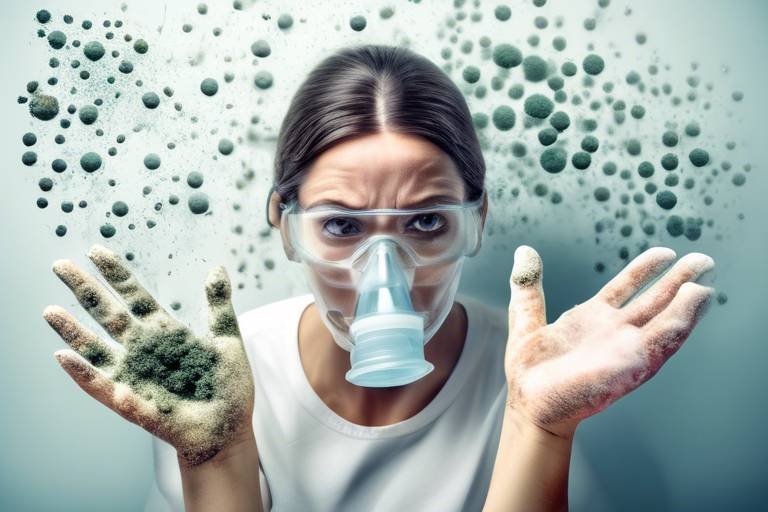The Chemistry of Mold - Prevention and Health Risks
This article explores the scientific aspects of mold, its health implications, and effective prevention strategies to ensure a safe living environment. Understanding mold chemistry is crucial for effective management and remediation.
Mold is a type of fungus that thrives in damp environments. It is composed of tiny spores that are invisible to the naked eye and can be found almost everywhere, both indoors and outdoors. These spores are incredibly resilient, capable of surviving in harsh conditions, and can remain dormant until they encounter moisture. The biological structure of mold includes hyphae, which are long, thread-like structures that spread through the material it colonizes. When conditions are just right—specifically, when moisture levels are elevated—these spores germinate, leading to the growth of mold colonies.
The life cycle of mold typically includes several stages: spore germination, hyphal growth, and reproduction. During the reproductive phase, mold can produce more spores, which can be easily dispersed by air currents, leading to further infestations. This is why controlling moisture in your home is essential; it disrupts the mold's ability to grow and reproduce. Understanding these biological processes not only helps in recognizing mold presence but also in implementing effective prevention strategies.
There are numerous mold species, each with distinct characteristics. Understanding these different types is crucial for effective management. Here’s an overview of the most common types of mold found indoors:
| Mold Type | Appearance | Potential Health Effects |
|---|---|---|
| Aspergillus | Green, yellow, or black | Allergic reactions, respiratory issues |
| Penicillium | Blue or green | Allergies, sinus infections |
| Stachybotrys (Black Mold) | Black or dark green | Severe respiratory problems, toxicity |
| Cladosporium | Green or black | Allergic reactions, asthma attacks |
Certain molds can trigger allergic reactions in sensitive individuals. For instance, Aspergillus and Cladosporium are common culprits that can exacerbate asthma and other respiratory issues. It's essential to be aware of these molds, especially if you or someone in your household has a history of allergies. The impact on respiratory health can be significant, leading to chronic coughing, sneezing, and even more severe conditions if left unaddressed.
Some molds produce mycotoxins that can be harmful to human health. Stachybotrys, often referred to as black mold, is notorious for its toxicity. Exposure to this mold can lead to a range of health problems, including neurological issues and immune system suppression. Prompt identification and remediation are crucial to mitigate these risks, especially in homes with vulnerable populations, such as children and the elderly.
Pathogenic molds can cause infections, particularly in immunocompromised individuals. Molds like Aspergillus can lead to serious infections in people with weakened immune systems, such as those undergoing chemotherapy or living with HIV/AIDS. It's vital to recognize the risks associated with these molds and to take preventive measures seriously.
Exposure to mold can lead to various health issues, ranging from mild allergic reactions to severe respiratory problems. Symptoms may include:
- Coughing and wheezing
- Nasal congestion and runny nose
- Skin irritation
- Fatigue and headaches
Long-term exposure can result in chronic respiratory conditions and other serious health complications. Therefore, understanding the health risks associated with mold exposure is crucial for maintaining a healthy living environment.
Preventing mold growth is essential for maintaining a healthy environment. Effective strategies include moisture control, proper ventilation, and regular inspections. Keeping your home dry and well-ventilated can significantly reduce the likelihood of mold infestations. For instance, using exhaust fans in bathrooms and kitchens can help reduce humidity levels, while regularly checking for leaks can prevent moisture accumulation.
Controlling indoor humidity is vital for mold prevention. Practical techniques include:
- Using dehumidifiers in damp areas
- Ensuring proper ventilation in all rooms
- Fixing leaks and water damage promptly
By maintaining optimal humidity levels, you can create an environment that is inhospitable to mold growth.
Effective cleaning and remediation methods are crucial for managing mold infestations. If you discover mold in your home, safe cleaning practices include:
- Wearing protective gear, such as gloves and masks
- Using soap and water for small areas of mold
- For larger infestations, it may be necessary to seek professional help
Professional mold remediation services can ensure that the infestation is thoroughly addressed, preventing future growth and ensuring the safety of your home.
1. What causes mold to grow?
Mold thrives in damp, warm environments with poor ventilation. Moisture is the primary factor that promotes mold growth.
2. How can I tell if I have mold in my home?
Look for visible signs of mold, such as discoloration on walls or ceilings, and be aware of musty odors. If you experience unexplained health issues, it may also indicate mold presence.
3. Can I remove mold myself?
For small areas, you can clean mold with soap and water, but larger infestations should be handled by professionals to ensure safety and thorough removal.
4. How can I prevent mold from returning?
Maintain low humidity levels, fix leaks promptly, and ensure proper ventilation in your home to prevent mold from returning.

Understanding Mold Biology
Mold is a fascinating yet often misunderstood type of fungus that thrives in damp environments. To truly grasp the implications of mold in our lives, it’s essential to dive into its biological structure and life cycle. Mold spores are microscopic and can remain dormant for extended periods, waiting for the right conditions to spring into action. These spores are ubiquitous in our environment, meaning they are present almost everywhere—both indoors and outdoors. When the conditions are just right, such as high humidity and organic material for food, these spores can germinate and grow into visible mold colonies.
The biological structure of mold consists of long, thread-like structures called hyphae. These hyphae spread out and form a network known as mycelium, which is essentially the root system of the mold. This structure allows the mold to absorb nutrients from its surroundings, enabling it to grow and reproduce. Mold reproduces through the release of spores, which can easily be carried by air currents, making it challenging to control once it establishes itself in a space.
Understanding the life cycle of mold is crucial for effective prevention and management. The cycle begins with the release of spores, which can land on suitable surfaces. If the surface is damp and has organic material, the spores can germinate within 24 to 48 hours. Once germination occurs, the mold begins to grow and spread, forming colonies that can quickly multiply. These colonies can produce even more spores, leading to an exponential increase in mold presence if left unchecked.
To summarize, the key conditions that promote mold growth include:
- Moisture: High humidity levels or water leaks create a perfect breeding ground.
- Organic Material: Mold feeds on materials like wood, paper, and even dust.
- Temperature: Mold generally thrives in warm environments, typically between 60°F and 80°F (15°C to 27°C).
By understanding these biological aspects, we can take proactive measures to control mold growth in our homes and workplaces. The first step in mold prevention is managing moisture levels. This means addressing leaks, using dehumidifiers, and ensuring proper ventilation in areas prone to dampness, such as bathrooms and basements. Remember, knowledge is power when it comes to mold management!

Common Types of Mold
Mold is a fascinating yet often troublesome organism that can be found in various environments, particularly indoors. Understanding the common types of mold is essential for anyone looking to maintain a healthy living space. Mold species vary widely in appearance, habitat, and health effects, making it crucial to identify them correctly. Some molds are relatively harmless, while others can pose significant health risks. To help you navigate this complex world, we’ll explore several common types of mold, highlighting their characteristics and potential impacts on your health.
One of the most frequently encountered molds in homes is Aspergillus. This mold species is typically found in soil, decaying vegetation, and indoor environments where moisture is present. Aspergillus can appear in various colors, including green, yellow, and black. While not all Aspergillus species are harmful, some can produce mycotoxins that may lead to respiratory issues or allergic reactions. It's essential to be aware of this mold, especially if you have allergies or asthma.
Another common type is Cladosporium, which is often found in damp areas like bathrooms and kitchens. This mold usually appears as a dark green or black patch and thrives on organic materials. Cladosporium is known for causing allergic reactions, particularly in individuals with pre-existing respiratory conditions. Its spores can easily become airborne, making it a significant concern for indoor air quality.
Then we have Penicillium, a mold that can often be spotted on old bread or spoiled food. This mold is typically blue or green and can also be found on damp building materials. While some species of Penicillium are used to create antibiotics, others can cause allergic reactions and respiratory problems. It’s a classic example of how mold can be both beneficial and harmful, depending on the context.
Finally, let’s talk about Stachybotrys chartarum, commonly known as “black mold.” This notorious mold is often linked to water damage and can be extremely harmful to health. Stachybotrys appears as a black or dark green slimy patch and thrives in environments with high humidity. Exposure to black mold can lead to serious health issues, including chronic respiratory problems and neurological symptoms. If you suspect the presence of black mold in your home, it’s crucial to take immediate action.
To summarize, here’s a quick reference table of the common types of mold, their characteristics, and potential health effects:
| Mold Type | Appearance | Common Locations | Health Effects |
|---|---|---|---|
| Aspergillus | Green, yellow, or black | Soil, decaying vegetation, indoor | Respiratory issues, allergic reactions |
| Cladosporium | Dark green or black | Bathrooms, kitchens | Allergic reactions, respiratory problems |
| Penicillium | Blue or green | Old food, damp materials | Allergic reactions, respiratory issues |
| Stachybotrys chartarum | Black or dark green | Water-damaged areas | Severe respiratory problems, neurological symptoms |
Understanding these common types of mold is the first step in protecting yourself and your family. By being aware of their characteristics and health effects, you can take proactive measures to prevent mold growth in your home. Remember, a little knowledge goes a long way in ensuring a safe and healthy living environment!
- What should I do if I find mold in my home? It's essential to address mold issues promptly. Depending on the extent, you may be able to clean it yourself or need to hire a professional.
- Can all molds be harmful? Not all molds are harmful, but it’s best to avoid exposure to any type of mold, especially if you have allergies or respiratory issues.
- How can I prevent mold growth? Keeping humidity levels low, ensuring proper ventilation, and addressing leaks quickly can help prevent mold growth.

Allergenic Molds
Mold is not just an unsightly visitor in your home; it can also be a sneaky culprit behind various health issues. Among the many types of mold, are particularly notorious for triggering allergic reactions in sensitive individuals. These molds thrive in damp and humid environments, making them a common problem in areas like bathrooms, kitchens, and basements. But what exactly are allergenic molds, and how do they affect our health? Let's dive into this fascinating yet concerning topic.
Allergenic molds release tiny spores into the air, which can be inhaled or come into contact with the skin. When these spores enter the body of someone who is allergic, the immune system may react as if they are harmful invaders, leading to a range of symptoms. Common reactions include sneezing, nasal congestion, itchy eyes, and skin rashes. In some cases, exposure to allergenic molds can exacerbate existing respiratory conditions such as asthma, making it crucial for individuals to be aware of their surroundings.
Some of the most prevalent allergenic molds include:
- Cladosporium: Often found on decaying organic matter, this mold can be grayish-green and is usually present outdoors but can also infiltrate homes.
- Penicillium: Recognizable by its blue or green appearance, Penicillium is commonly found in damp areas and can grow on food, causing spoilage.
- Alternaria: This mold thrives in both indoor and outdoor environments, often appearing as dark green or brown patches, and is known to trigger asthma attacks.
- Aspergillus: A very common mold in homes, Aspergillus can vary in color and is often found in dust, soil, and building materials.
Understanding the types of allergenic molds is just the first step. The next crucial aspect is recognizing the symptoms associated with exposure. These symptoms can range from mild to severe and may include:
- Runny or stuffy nose
- Frequent sneezing
- Itchy or watery eyes
- Skin rashes or irritation
- Coughing or wheezing
For those who are particularly sensitive, exposure to these molds can lead to chronic respiratory issues or even trigger asthma attacks. Imagine your immune system reacting to something as harmless as mold spores; it’s like a fire alarm going off for no reason! This is why awareness and prevention are key. Regular cleaning, maintaining low humidity levels, and ensuring proper ventilation in your home can significantly reduce the risk of mold growth.
In conclusion, allergenic molds may seem like a minor inconvenience, but their potential health impacts are anything but trivial. By understanding the types of molds that can cause allergic reactions and recognizing the symptoms associated with them, you can take proactive steps to ensure a healthier living environment. Remember, a little knowledge goes a long way in keeping your home safe from these pesky intruders!
Q: What are allergenic molds?
A: Allergenic molds are types of mold that can trigger allergic reactions in sensitive individuals, leading to symptoms such as sneezing, nasal congestion, and skin rashes.
Q: Where are allergenic molds commonly found?
A: They are typically found in damp areas of the home, such as bathrooms, kitchens, and basements, as well as on decaying organic matter outdoors.
Q: How can I prevent allergenic mold growth in my home?
A: To prevent mold growth, maintain low humidity levels, ensure proper ventilation, and conduct regular cleaning to eliminate potential mold sources.
Q: What should I do if I suspect mold in my home?
A: If you suspect mold growth, it’s important to address the issue promptly. Clean small areas with appropriate cleaning solutions or consult a professional for larger infestations.

Toxic Molds
Toxic molds are not just a nuisance; they can pose serious health risks to humans and animals alike. One of the most notorious types is Stachybotrys chartarum, commonly known as black mold. This mold produces mycotoxins, which are harmful substances that can lead to a range of health issues. While not all molds are toxic, the ones that are can create significant problems, especially in poorly ventilated and damp areas.
When toxic molds grow indoors, they release spores and mycotoxins into the air, which can be inhaled or come into contact with skin. This exposure can lead to a variety of symptoms, including persistent coughing, sneezing, skin rashes, and even more severe respiratory issues. In some cases, individuals may experience neurological symptoms, such as headaches and memory loss, which can be alarming and lead to further health complications.
Understanding the types of toxic molds is crucial for effective management. Here’s a brief overview of some common toxic molds and their potential health effects:
| Mold Type | Common Locations | Health Effects |
|---|---|---|
| Stachybotrys chartarum (Black Mold) | Wet areas, bathrooms, basements | Respiratory issues, fatigue, headaches |
| Aspergillus | Dusty areas, air conditioning systems | Allergic reactions, lung infections |
| Penicillium | Water-damaged buildings, carpets | Allergic responses, sinus infections |
It’s essential for homeowners and tenants to be aware of the signs of toxic mold. If you notice a musty smell, discoloration on walls or ceilings, or water damage, it’s time to take action. Regular inspections and moisture control can help prevent these molds from taking root in your living spaces.
In summary, toxic molds can have a profound impact on health, making it critical to identify and remediate mold infestations promptly. If you suspect that your home may be harboring toxic mold, consider consulting a professional for an assessment and remediation. Remember, early detection is key to ensuring a safe and healthy living environment.
- What are the symptoms of toxic mold exposure? Symptoms can vary but often include respiratory issues, headaches, fatigue, and skin irritations.
- How can I prevent toxic mold growth in my home? Maintaining low humidity levels, ensuring proper ventilation, and addressing any water leaks promptly can help prevent mold growth.
- Should I remove toxic mold myself? While small patches can be cleaned, extensive infestations should be handled by professionals to ensure safety and thorough removal.

Pathogenic Molds
Pathogenic molds are a group of fungi that can cause infections, particularly in individuals with weakened immune systems. These molds thrive in environments that are damp and poorly ventilated, making them a significant concern in both residential and commercial settings. Unlike other molds that may merely cause allergic reactions, pathogenic molds can lead to serious health issues, including respiratory infections and systemic diseases. This makes understanding their characteristics and risks crucial for effective prevention and management.
One of the most notorious pathogenic molds is Aspergillus, which can be found in decaying vegetation and damp buildings. There are several species within this genus, but Aspergillus fumigatus is particularly concerning as it can cause a range of diseases, from allergic reactions to severe lung infections known as aspergillosis. Symptoms of aspergillosis can range from mild respiratory issues to life-threatening conditions, especially in immunocompromised individuals, such as those undergoing chemotherapy or living with HIV/AIDS.
Another significant pathogen is Candida, a yeast-like fungus that can cause infections when it overgrows in the body. While it's a common inhabitant of our skin and mucous membranes, it can lead to serious infections like candidiasis, particularly in patients with weakened immune systems. The most severe form can enter the bloodstream, leading to a condition known as candidemia, which can be fatal if not treated promptly.
Moreover, Stachybotrys chartarum, commonly known as black mold, is infamous for its health risks. It produces mycotoxins that can lead to serious respiratory problems, including chronic coughing and difficulty breathing. This mold is often found in water-damaged buildings, making it essential for homeowners and tenants to address any leaks or moisture issues quickly.
Identifying and addressing pathogenic molds is not just about maintaining a clean environment; it is a matter of health. Individuals at the highest risk include:
- People with weakened immune systems
- Individuals with chronic lung diseases
- The elderly and very young children
To mitigate the risks associated with pathogenic molds, it's vital to maintain a dry environment and ensure proper ventilation. Regular inspections of areas prone to moisture, such as bathrooms, kitchens, and basements, can help catch mold growth early before it becomes a significant health issue. If mold is detected, it is essential to take immediate action, whether through thorough cleaning or by contacting professionals for remediation.
What are the symptoms of mold exposure?
Symptoms can vary widely but often include respiratory issues, allergic reactions, and in severe cases, systemic infections. Common symptoms include coughing, sneezing, nasal congestion, and skin rashes.
How can I prevent mold growth in my home?
Preventing mold growth involves controlling humidity levels, ensuring proper ventilation, and fixing leaks promptly. Regular cleaning and inspection of damp areas are also crucial.
When should I seek professional help for mold removal?
If you encounter extensive mold growth or suspect the presence of pathogenic molds, it is advisable to seek professional remediation services to ensure safe and effective removal.

Health Risks Associated with Mold Exposure
Mold exposure can lead to a variety of health issues, which can range from mild to severe, depending on the individual’s sensitivity and the type of mold present. For many, the presence of mold in their home can be a source of concern, and rightly so. When you breathe in mold spores, your body may react in ways that can affect your overall health. It's essential to recognize the symptoms associated with mold exposure, as they can often be mistaken for other illnesses.
Some of the most common health issues linked to mold exposure include:
- Allergic Reactions: Many individuals experience allergic reactions to mold spores. Symptoms can include sneezing, runny or stuffy nose, itchy eyes, and skin rashes. For those with pre-existing allergies, mold can exacerbate their conditions, leading to more severe reactions.
- Respiratory Problems: Mold can irritate the respiratory system, causing symptoms like coughing, wheezing, and difficulty breathing. This is particularly concerning for individuals with asthma or other chronic respiratory conditions.
- Infections: Certain molds can lead to infections in immunocompromised individuals. For example, people undergoing chemotherapy or those with HIV/AIDS are at a greater risk of developing serious health complications due to mold exposure.
Moreover, prolonged exposure to mold can lead to chronic health issues. Studies have shown that individuals living in mold-infested environments may experience long-term respiratory problems, including asthma development and chronic obstructive pulmonary disease (COPD). The effects can be particularly damaging for children, as their developing lungs are more susceptible to the harmful effects of mold.
To better understand the health risks associated with mold exposure, let's look at a table that summarizes the different types of health effects and their severity:
| Health Effect | Severity Level | Common Symptoms |
|---|---|---|
| Allergic Reactions | Mild to Moderate | Sneezing, itchy eyes, skin rashes |
| Respiratory Issues | Moderate to Severe | Coughing, wheezing, difficulty breathing |
| Infections | Severe | Fever, fatigue, persistent cough |
| Chronic Health Conditions | Long-term | Asthma, COPD, lung infections |
It's important to note that not everyone will experience symptoms from mold exposure. Factors such as individual health status, the amount of mold present, and the duration of exposure all play a significant role. However, if you notice any of the symptoms mentioned above, it’s crucial to address the mold issue promptly. Ignoring mold can lead to worsening health conditions and more extensive remediation efforts down the line.
In conclusion, understanding the health risks associated with mold exposure is vital for maintaining a safe and healthy living environment. Awareness and prompt action can make a significant difference in preventing health complications related to mold.
What should I do if I find mold in my home?
If you discover mold, it's essential to address it immediately. Small areas can often be cleaned with soap and water, but larger infestations may require professional remediation.
Can mold cause long-term health issues?
Yes, prolonged exposure to mold can lead to chronic respiratory problems and other serious health conditions, especially in sensitive individuals.
How can I prevent mold growth in my home?
Preventing mold growth involves controlling humidity levels, ensuring proper ventilation, and conducting regular inspections for leaks or water damage.

Preventive Measures for Mold Growth
Preventing mold growth is crucial for ensuring a healthy living environment. Mold thrives in damp conditions, so the key to keeping it at bay lies in moisture control. Imagine your home as a fortress against mold; if you can keep the moisture levels low, you can significantly reduce the chances of mold taking root. To achieve this, you need to focus on a few essential strategies that will help you maintain a dry and clean space.
First and foremost, humidity control is vital. Keeping indoor humidity levels below 60% can make a world of difference. You can achieve this by using dehumidifiers in areas prone to moisture, like basements and bathrooms. Additionally, ensure that your home is well-ventilated. Open windows when possible, and consider installing exhaust fans in moisture-heavy areas to help circulate air and reduce humidity.
Another effective measure is to conduct regular inspections of your home. Check for leaks in your plumbing and roof, as even the tiniest drip can create a perfect environment for mold growth. If you notice any signs of moisture, such as water stains on walls or ceilings, address them immediately. Remember, mold doesn’t need much to thrive; a small leak can lead to a big problem!
Cleaning is also essential in mold prevention. Regularly clean areas that are prone to moisture accumulation, such as shower curtains, bathroom tiles, and kitchen sinks. Use mold-resistant products when painting or renovating, and consider applying a mold inhibitor to surfaces that are frequently exposed to water.
Here’s a quick overview of some effective preventive measures:
- Maintain indoor humidity below 60%
- Use dehumidifiers in damp areas
- Ensure proper ventilation in moisture-prone spaces
- Regularly inspect for leaks and signs of moisture
- Clean and maintain areas susceptible to mold growth
Lastly, don't underestimate the power of proper drainage around your home. Ensure that gutters and downspouts direct water away from the foundation. This simple step can prevent water from seeping into your basement or crawl space, where mold can flourish.
By implementing these preventive measures, you can create an environment that is less hospitable to mold and more enjoyable for you and your family. Remember, the goal is to stay one step ahead of mold, keeping your home safe and healthy.
Q: How can I tell if I have a mold problem in my home?
A: Look for visible signs such as black spots or discoloration on walls, a musty odor, or increased allergy symptoms among household members.
Q: Can I remove mold myself?
A: Small areas of mold can often be cleaned with soap and water; however, for larger infestations or toxic mold, it's best to call a professional.
Q: What humidity level is ideal for preventing mold?
A: Keeping indoor humidity below 60% is considered ideal for preventing mold growth.
Q: How often should I check for leaks in my home?
A: It's a good practice to inspect your home for leaks at least once every few months, especially after heavy rain or snow.

Humidity Control Techniques
Controlling indoor humidity is a fundamental step in preventing mold growth and ensuring a healthy living environment. High humidity levels can create a paradise for mold spores, allowing them to thrive and multiply. So, how do we keep our homes from turning into moldy jungles? Here are some practical techniques that can help you maintain optimal humidity levels in your home or workplace.
One of the most effective methods for controlling humidity is the use of dehumidifiers. These handy appliances work by pulling moisture from the air, which can significantly lower humidity levels. They are particularly beneficial in areas that are prone to dampness, such as basements or bathrooms. When selecting a dehumidifier, consider the size of the space and the humidity levels you typically experience. A table like the one below can help you choose the right unit:
| Room Size (sq. ft.) | Recommended Dehumidifier Capacity (pints/day) |
|---|---|
| 500 | 30 |
| 1,000 | 40 |
| 1,500 | 50 |
| 2,000+ | 60+ |
In addition to using dehumidifiers, proper ventilation is essential for controlling humidity. This means ensuring that air can circulate freely throughout your home. Open windows when possible, use exhaust fans in kitchens and bathrooms, and consider installing vents in areas that tend to trap moisture. Good ventilation not only helps reduce humidity but also improves air quality by allowing fresh air to enter and stale air to exit.
Another effective technique is to monitor indoor humidity levels using a hygrometer. This small device measures the moisture content in the air and can help you keep track of whether your humidity levels are too high. Ideally, indoor humidity should be maintained between 30% and 50%. If your hygrometer indicates higher levels, it might be time to take action.
Lastly, it's crucial to address any sources of moisture in your home. This includes fixing leaks, ensuring that gutters and downspouts direct water away from your foundation, and using moisture barriers in crawl spaces. Regularly inspecting your home for water damage or signs of mold can prevent small issues from becoming big problems.
In summary, maintaining optimal humidity levels is key to preventing mold growth. By using dehumidifiers, ensuring proper ventilation, monitoring humidity levels, and addressing moisture sources, you can create a healthier environment for you and your family. Remember, a little bit of moisture control goes a long way in keeping mold at bay!
- What humidity level is considered ideal for indoor spaces? The ideal indoor humidity level is between 30% and 50%.
- How can I tell if I need a dehumidifier? If you notice condensation on windows, musty odors, or visible mold, it may be time to invest in a dehumidifier.
- Can I use my air conditioner to control humidity? Yes, air conditioners can help reduce humidity levels, but they may not be as effective as a dedicated dehumidifier in very humid conditions.

Cleaning and Remediation Strategies
When it comes to tackling mold infestations, having effective is essential for ensuring a healthy living environment. Mold can be a sneaky little intruder, often hiding in places we can't see, so it's crucial to be proactive and thorough in our approach. First and foremost, it's important to understand that not all mold can be safely cleaned by homeowners. For larger infestations, or if you're dealing with toxic molds, it might be best to call in the professionals. But for smaller patches, you can take matters into your own hands!
Before diving into the cleaning process, make sure to equip yourself with the right protective gear. This includes gloves, goggles, and a mask to prevent inhalation of mold spores. Remember, safety first! Once you're geared up, you can start by isolating the affected area. Close off doors and windows to prevent spores from spreading to other parts of your home.
Now, onto the cleaning! Here are some effective steps you can follow:
- Identify the Source of Moisture: Mold thrives in damp conditions, so pinpointing the source of moisture is crucial. Whether it's a leaky pipe, high humidity, or poor ventilation, addressing this issue is the first step in effective remediation.
- Use the Right Cleaning Solutions: A mixture of water and detergent can be effective for non-porous surfaces. For more stubborn mold, consider using a solution of one cup of bleach to one gallon of water. However, be cautious with bleach; it should never be mixed with ammonia.
- Scrub Thoroughly: Use a scrub brush or sponge to apply your cleaning solution to the affected area. Make sure to scrub away all visible mold, as any remaining spores can lead to regrowth.
- Dry the Area Completely: After cleaning, it's vital to dry the area thoroughly. Use fans or dehumidifiers to ensure that no moisture is left behind, as this can lead to mold returning.
In some cases, you might find that the mold has penetrated porous materials such as drywall or carpet. In these instances, it’s often best to remove and replace the affected materials entirely. This not only ensures that all mold is eliminated but also helps to prevent future infestations.
It's also essential to conduct regular inspections of your home, especially in areas prone to moisture like bathrooms, kitchens, and basements. Keeping an eye out for any signs of mold can save you from larger headaches down the line. If you do notice mold returning, it may be time to reassess your moisture control strategies.
In summary, cleaning and remediation strategies for mold require a combination of thorough cleaning, moisture control, and ongoing vigilance. By taking these steps, you can create a safer environment for yourself and your loved ones.
Q: How can I tell if I have mold in my home?
A: Look for visible signs such as discoloration on walls, a musty smell, or water stains. If you suspect mold but can't see it, consider using a mold test kit.
Q: Can I use vinegar to clean mold?
A: Yes, vinegar is a natural mold killer. You can spray undiluted vinegar on the affected area and let it sit for an hour before scrubbing.
Q: How do I prevent mold from coming back?
A: Control humidity levels, ensure proper ventilation, and fix any leaks promptly. Regular inspections can also help catch mold early before it becomes a larger issue.
Frequently Asked Questions
- What is mold and why does it grow?
Mold is a type of fungus that thrives in damp, warm environments. It reproduces by releasing spores into the air, which can settle on surfaces and grow when moisture is present. Think of it like a tiny plant that needs water and warmth to flourish!
- What are the health risks associated with mold exposure?
Exposure to mold can lead to a variety of health issues, from mild allergic reactions like sneezing and coughing to more severe respiratory problems. Some molds can even produce toxic substances that may affect your health over time. It's crucial to take mold seriously!
- How can I prevent mold growth in my home?
Preventing mold growth is all about controlling moisture. Here are some effective strategies:
- Use dehumidifiers to keep humidity levels low.
- Ensure proper ventilation in bathrooms and kitchens.
- Regularly inspect areas prone to moisture, like basements and attics.
- What should I do if I find mold in my home?
If you discover mold, it's important to act quickly. For small areas, you can clean it with a mixture of water and detergent. However, for larger infestations, it's best to call in professionals who can safely remove it and prevent it from coming back.
- Are all molds harmful?
No, not all molds are harmful. However, some molds can produce allergens or toxins that may pose health risks, especially to sensitive individuals or those with compromised immune systems. It's always a good idea to identify and manage any mold you find.
- How can I tell if I have a mold problem?
Look for visible signs of mold, such as black or green patches on walls or ceilings. You might also notice a musty smell in certain areas of your home. If you experience unexplained health issues, it could be a sign of mold lurking nearby!
- Can I remove mold myself?
For small patches of mold, you can often clean it yourself using soap and water or a vinegar solution. However, if the affected area is larger than 10 square feet, it's advisable to hire professionals to ensure safe and thorough removal.
- What are the most common types of mold found indoors?
Some common types of indoor mold include:
- Aspergillus
- Penicillium
- Cladosporium
- Stachybotrys (black mold)
Each type can have different health effects, so it's important to be aware of them!



















